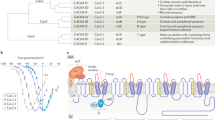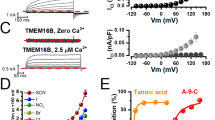Abstract
Depolarisation–secretion coupling at presynaptic nerve terminals is thought to be mediated by the influx of calcium ions from the extracellular fluid through voltage-sensitive channels in the nerve terminal membrane1. In physiological conditions, the depolarisation is accomplished when the nerve action potential invades the nerve-ending. At the neuromuscular junction, the nerve impulse promotes the synchronous release of many quanta of the transmitter, acetylcholine, the response to which is recorded postsynaptically as the endplate potential (e.p.p.)2. Strontium can substitute for Ca2+ in the support of transmitter release evoked by nerve impulses3–5, although it is far less effective (on a molar basis) in the generation of the e.p.p. It has been suggested5 that Sr3+ may be less accessible from the extracellular fluid during the action potential, and might not achieve as high a concentration as Ca2+ in the nerve ending so that it would seem less effective. Alternatively, intra-terminal releasing sites may exhibit true selectivity for divalent cations. To help distinguish between these possibilities, I have made use of the long-established observation that when nerve terminals are depolarised by elevating the extracellular potassium ion concentration ([K+]0), there is a dramatic increase in the frequency of spontaneous miniature endplate potentials (m.e.p.ps)6–9. This is thought also to be a form of depolarisation-secretion coupling (that is, mediated by Ca2+ entry through voltage-gated channels), though of relatively long duration. I have compared the relative abilities of Ca2+ and Sr2+ in supporting the augmented m.e.p.p. frequency seen in high K+ Ringer's solutions and report here that they are qualitatively and quantitatively equivalent, in contrast to their differences in the nerve impulse-evoked e.p.p.
This is a preview of subscription content, access via your institution
Access options
Subscribe to this journal
Receive 51 print issues and online access
$199.00 per year
only $3.90 per issue
Buy this article
- Purchase on Springer Link
- Instant access to full article PDF
Prices may be subject to local taxes which are calculated during checkout
Similar content being viewed by others
References
Katz, B. The Release of Neural Transmitter Substances (University Press, Liverpool, 1969).
del Castillo, J. & Katz, B. J. Physiol, Land. 124, 560–573 (1954).
Miledi, R. Nature 212, 1233–1234 (1966).
Dodge, F. A., Miledi, R. & Rahamimoff, R. J. Physio., Lond. 200, 267–283 (1969).
Meiri, U. & Rahamimoff, R. J. Physiol., Lond. 215, 709–726 (1971).
Liley, A. W. J. Physiol., Lond. 134, 427–443 (1956).
Gage, P. W. & Quastel, D. M. J. Nature 206, 625–626 (1965).
Cooke, J. D. & Quastel, D. M. J. J. Physiol., Lond. 228, 435–458 (1973).
Matthews, G. & Wickelgren, W. O. J. Physiol., Lond. 266, 91–101 (1977).
Birks, R. I., Burstyn, P. G. R. & Firth, D. R. J. gen. Physiol. 52, 887–907 (1968).
Gage, P. W. & Quastel, D. M. J. J. Physiol., Lond. 185, 95–123 (1966).
Hille, B., Woodhull, A. M. & Shapiro, B. I. Phil. Trans. R. Soc. B270, 301–318 (1975).
McLaughlin, S. G. A., Szabo, G. & Eisenman, G. J. gen. Physiol. 58, 667–687 (1971).
Hodgkin, A. L. & Horowicz, P. J. Physiol., Lond. 148, 127–160 (1959).
Katz, B. & Miledi, R. J. Physiol., Lond. 203, 459–487 (1969).
Katz, B. & Miledi, R. J. Physiol., Lond. 216, 503–512 (1971).
Llinás, R., Steinberg, I. Z. & Walton, K. Proc. natn. Acad. Sci. U.S.A. 73, 2918–2922 (1976).
Illes, P. & Thesleflf, S., Br. J. Pharmac. 64, 623–629 (1978).
Llinás, R., Walton, K. & Bohr, V. Biophys. J. 16, 83–86 (1976).
Author information
Authors and Affiliations
Rights and permissions
About this article
Cite this article
Mellow, A. Equivalence of Ca2+ and Sr2+ in transmitter release from K+-depolarised nerve terminals. Nature 282, 84–85 (1979). https://doi.org/10.1038/282084a0
Received:
Accepted:
Issue Date:
DOI: https://doi.org/10.1038/282084a0
This article is cited by
-
Calcium localization in nerve fibers in relation to axoplasmic transport
Neurochemical Research (1984)
Comments
By submitting a comment you agree to abide by our Terms and Community Guidelines. If you find something abusive or that does not comply with our terms or guidelines please flag it as inappropriate.



